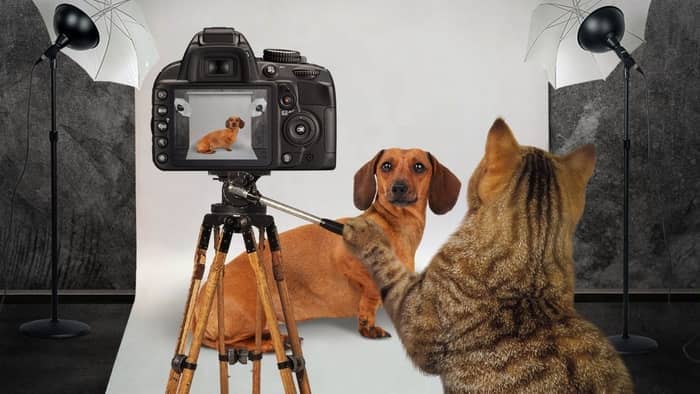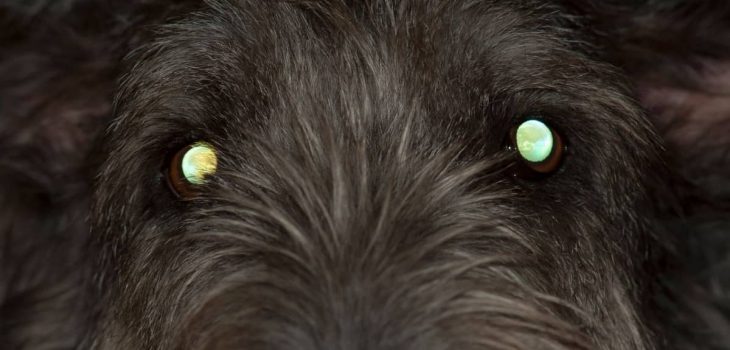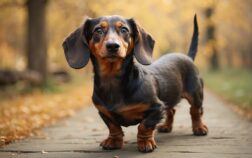Have you ever wondered why dogs’ eyes shine in the dark? Here’s a quick dog eye reflection color chart and why dogs’ eyes glow in different colors. Not many people would choose a dog based on the color its eyes would reflect, of course. Still, it is fun to know what spooky color your dog’s eyes will glow with when you try to take a picture of it.
Dog Eye Reflection Color Chart
First and foremost, keep in mind that there are no guarantees when it comes to the eye reflection color – or eyeshine – of your dog’s eyes. These eyeshines can vary anywhere between light yellow and light green through bright blue, turquoise, and purplish, all the way to orange and red.
Generally, the color of the eyeshine will depend on the dog’s eye color as well as on its breed and even its coat color. We’ll explain below exactly what makes dogs’ eyes glow too.
But, to give you a general idea of the eyeshine you can expect from some popular breeds, here’s a quick dog eye reflection color chart:
| Dog eye color, coat color, or breed | Usual dog eye reflection color |
| Siberian Husky | Red reflection |
| Blue eye color | Red reflection |
| Schnauzer | Blue or turquoise reflection |
| Yellow Labrador | Light yellow reflection |
| Black Labrador | Deeper yellow or green reflection |
| White coat | Red reflection |
| English Springer Spaniel | Orange reflection |
Why Are Dogs Eyes Reflective?
Dogs’ eyes glow in the dark for the same reason cats’ eyes glow too – it’s because of their night vision. Simply put, nocturnal and cathemeral (active both during the night and day) animals have reflective eyes to help them see better under reduced visibility.
The way that works is that these animals’ eyes have a reflective surface at the back of the eye. This surface is called a tapetum lucidum and it’s located between the optic nerve and the retina. The purpose of the tapetum is precisely to reflect all incoming light back through the eye. This helps the dog see better because the light has to go through the eye’s visual cells (eye cones and rods) a second time.
Essentially, the tapetum lucidum gives the dog’s eyes a second chance to detect any information in the light they’ve seen, no matter how dim it is. The fact that the light is then reflected out of the eye, while spooky, is just a side-effect.
The reason the tapetum lucidum is reflective is due to the presence of zinc and/or riboflavin in the pigment of its cells. As Dr. Cynthia Powell of the Colorado State University explains it “Zinc is a metal, and riboflavin is an amino acid and both act as reflective agents. Depending on how densely packed these cells are with zinc or riboflavin, the glow color can vary from animal to animal and breed to breed.”
Do All Dogs Have Reflective Eyes?
Not all dogs have a reflective tapetum, however. As this study published in the Acta Veterinaria Scandinavica journal shows, 1.9% of dogs have no tapetal area at all. In such dogs, however, there is still a noticeable reflecting. Only, in this case, it has a reddish or orange glow because the light reflects off the blood vessels at the back of the eye. A similar color happens when the dog has blue eyes.
Additionally, as you can see in the pictures attached to the study, in most dogs the tapetum lucidum doesn’t cover the whole backside of the eye. And, in most cases, the tapetum’s color will have a few different hues that flow into each other. This further explains why each dog’s eyeshine is slightly different.
What’s more, in many dogs there were also differences in the reflected color of their eyes. Sometimes they are of a similar but slightly different color. Other times, both eyes have completely different reflections.
So, even though the dog eye reflection color chart above is true most of the time, it’s not a guarantee. In other words, it can’t really be used to predict a dog’s eye reflection color.
Does The Dog Eye Reflection Color Chart Apply To Puppies?
We know that puppies have different eye colors than adult dogs. Pups’ eyes go through quite a few changes as they grow, after all – we’ve detailed them here. So, naturally, the dog eye reflection you’ll see in a small puppy won’t be the same color as that of an adult dog.
The switch will usually happen gradually as does the eye color change too. The process will usually be done by the third month at the latest. both the eye color and the reflection color will be “done” by that point.
As for the eye reflection color you can expect in puppies – that will usually be an orange or reddish hue of some kind. The reason for that is the same as why blue-eyed dogs usually have such eye reflection color. The blue color is due to the low (or none) melanin pigment in the eye. That’s also why the tapetum lucidum is colorless. So, as the eye hits the back of the dog’s eye, it’s reflected off of the blood vessels there.
If the pup’s eyes change their color to the more common black, brown, or hazelnut colors, however, the eyeshine color will change as well.
How To Reduce The Eyeshine When Taking Pictures Of Your Dog?
While fascinating, the dog eye reflection color can be annoying when you’re trying to take a picture of your pooch. So, if you want to reduce or avoid the eyeshine altogether, here are a couple of tips you can try:
Take pictures without a flash. Make sure the surrounding ambient light is bright enough so that you don’t need a flash. At the same time, however, you should also make sure that said ambient light isn’t shining directly in the dog’s eyes. A further benefit of that is that the bright light will make your dog’s pupils smaller. So, even less light will be able to pass to the tapetum lucidum.
Alternatively, if you do have to use a flash, try to make sure the dog isn’t looking at the camera. For example, take the picture from above the dog but keep its attention close to the ground. This way it’s more likely that the light won’t be reflected directly back in the direction of the camera. You can also try using your camera’s multi-shot function and take a few pictures in close succession.

Learn more about: 16 Awesome Floppy Ear Dog Breeds




